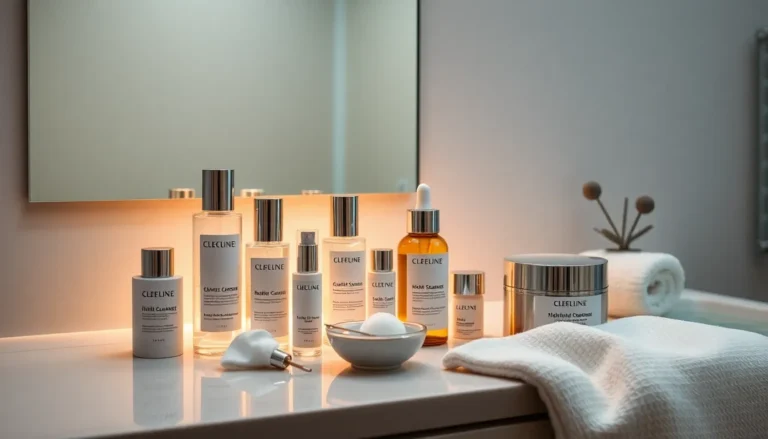Table of Contents
ToggleAchieving blemish-free skin can feel like chasing a unicorn—magical but elusive. But fear not, because with the right routine, that mythical glow is within reach. Picture this: a morning ritual that leaves you feeling like a radiant superstar and a night routine that whispers sweet nothings to your skin as you drift off to dreamland.
Understanding Blemish-Free Skin
Blemish-free skin reflects overall health and proper skincare. Achieving this requires understanding skin types and the various causes of blemishes.
Common Skin Types
Different skin types respond uniquely to products and environmental factors. Oily skin typically appears shiny and prone to breakouts, while dry skin often feels tight and may flake. Combination skin shows characteristics of both oily and dry areas, leading to a mix of concerns. Sensitive skin reacts easily to products and can appear red or inflamed. Recognizing individual skin type helps tailor a skincare approach for optimal results.
Causes of Blemishes
Multiple factors contribute to blemishes, encompassing hormonal changes, genetics, and environmental influences. Hormonal fluctuations, particularly during puberty or menstruation, often trigger increased oil production. Genetics can predispose individuals to acne-related issues. Environmental factors, like pollution and UV exposure, lead to skin damage and block pores. Additionally, improper skincare routines may result in clogged pores and breakouts. Understanding these causes aids in developing effective prevention strategies.
Essential Steps in a Daily Routine

A well-structured skincare routine ensures blemish-free skin. Following essential steps daily enhances skin health and appearance.
Cleansing
Cleansing removes impurities, dirt, and excess oil from the skin. Use a gentle cleanser tailored to skin type for morning and evening routines. Foam cleansers suit oily skin, while cream cleansers benefit dry skin. A proper cleansing routine minimizes the clogging of pores and reduces breakouts. Aim for a thorough yet gentle approach, using lukewarm water to maintain skin’s natural balance. For best results, consider double cleansing at night to eliminate makeup and impurities accumulated throughout the day.
Exfoliating
Exfoliation brightens and smooths the skin by removing dead skin cells. Chemical exfoliants, such as AHAs and BHAs, are effective for various skin types. Scrubs with physical exfoliants help slough off dead cells but may irritate sensitive skin. Aim to exfoliate 2-3 times per week to maintain a radiant complexion without overdoing it. Incorporate exfoliation into the evening routine to reveal fresh skin faster. Remember to follow up with a moisturizer to prevent dryness.
Toning
Toning restores pH balance after cleansing and preps skin for further treatments. Choose alcohol-free toners infused with beneficial ingredients like witch hazel or rose water. Such toners provide hydration while minimizing pores and soothing irritation. Apply toner using a cotton pad or by gently tapping it into the skin. This extra step enhances overall skin texture and promotes a clearer appearance. Perform toning twice daily for best results.
Moisturizing
Moisturizing hydrates the skin and forms a barrier against environmental factors. Use a lightweight moisturizer for oily skin and a richer cream for dry skin. Ingredients like hyaluronic acid and glycerin effectively hydrate while keeping skin plump. Apply moisturizer in both morning and evening routines to lock in hydration. Don’t skip this step, as it prevents excessive oil production and helps maintain skin’s elasticity. Consider a moisturizer with SPF for daytime protection against harmful UV rays.
Recommended Products for a Blemish-Free Routine
Achieving blemish-free skin involves selecting the right products tailored to individual needs. Below are some recommendations to enhance a blemish-free skincare routine.
Cleansers
Gentle foaming cleansers, like those containing salicylic acid, work effectively to target impurities. Gel cleansers offer a refreshing feel and help remove excess oil. Cream-based formulas provide hydration while cleansing, specifically for dry or sensitive skin. Look for sulfate-free options to avoid irritation. Consider brands like CeraVe, Neutrogena, and La Roche-Posay for reliable choices.
Exfoliators
Chemical exfoliants, such as those with glycolic or lactic acid, help remove dead skin cells without scrubbing too harshly. Regular use, ideally 1-2 times per week, promotes cell turnover and brightens the complexion. Physical scrubs offered by reputable brands can also be beneficial but should be used sparingly. Ensure that exfoliants contain soothing ingredients to minimize irritation, with Paula’s Choice and The Ordinary providing excellent options.
Moisturizers
Hydrating moisturizers that include non-comedogenic ingredients are vital for maintaining a healthy skin barrier. Gel-based moisturizers are perfect for oily skin, while cream formulations suit dry skin types. Products enriched with hyaluronic acid or niacinamide help retain moisture and reduce blemishes. Brands like First Aid Beauty and Neutrogena provide effective solutions for various skin types. Always prioritize moisturizers with SPF during the day for added protection.
Lifestyle Tips for Healthy Skin
Achieving healthy skin involves various lifestyle choices. Simple adjustments can significantly improve skin condition and reduce blemishes.
Diet and Nutrition
Diet plays a critical role in skin health. Eating a variety of fruits and vegetables provides essential vitamins and antioxidants. Omega-3 fatty acids found in fish, walnuts, and flaxseeds promote skin barrier function. Incorporating whole grains supports stable blood sugar levels, which helps prevent breakouts. Limiting processed foods, sugar, and dairy often leads to clearer skin for many individuals. Staying conscious of portion sizes also contributes to an overall healthier diet. A balanced intake of nutrients helps maintain skin vitality.
Hydration
Hydration significantly impacts skin appearance. Drinking adequate amounts of water daily keeps the skin plump and reduces dryness. Aim for at least 8 glasses or 64 ounces daily, adjusting based on individual activity levels and climate. Consuming moisture-rich foods like cucumbers, watermelon, and oranges also contributes to hydration. Herbal teas can be a beneficial alternative to sugary beverages, providing hydration without additional calories. Recognizing signs of dehydration, such as dryness or dullness, encourages proactive hydration efforts.
Stress Management
Managing stress is essential for maintaining healthy skin. High stress levels can trigger hormonal changes that lead to acne outbreaks. Engaging in relaxation techniques like yoga, meditation, or deep breathing exercises promotes overall well-being. Physical activity not only reduces stress but also improves circulation, helping deliver necessary nutrients to the skin. Setting aside time for hobbies and passions boosts mood and can enhance skin health. Establishing a consistent sleep routine further supports skin regeneration, making rest a vital component of skincare.
Achieving blemish-free skin is a journey that requires dedication and a tailored approach. By implementing a consistent skincare routine that caters to individual skin types and needs, anyone can make strides toward healthier skin. Incorporating the right products and techniques is essential for maintaining balance and preventing breakouts.
Moreover, lifestyle choices play a significant role in skin health. A balanced diet proper hydration and effective stress management techniques can enhance overall skin appearance. With patience and commitment to these practices achieving that radiant glow is within reach. Embracing this holistic approach not only improves skin but also boosts confidence and well-being.




